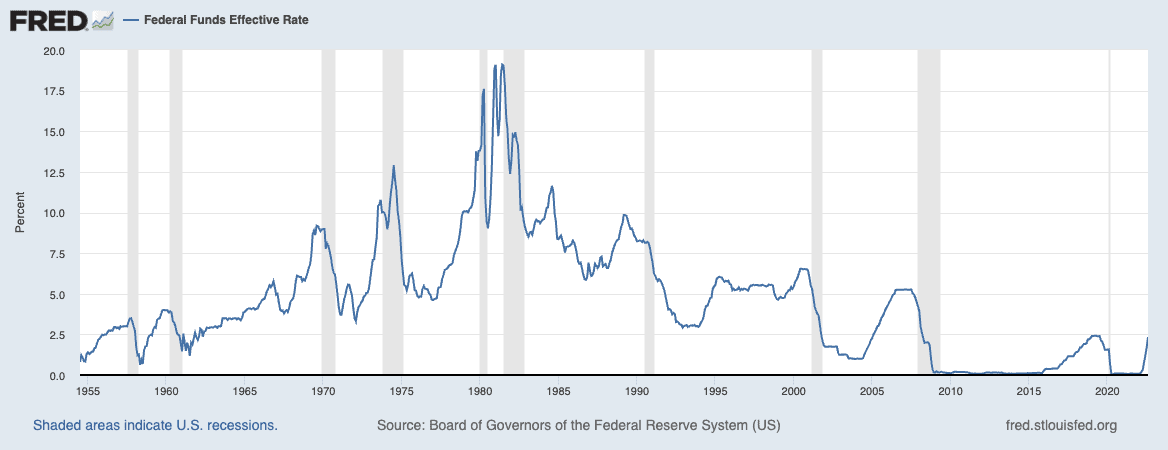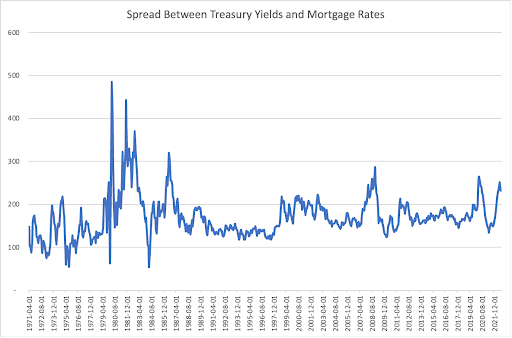This week, the Federal Reserve hiked the federal funds interest rate 75 basis points, which was widely expected. But there is more to Fed meetings than the headline rate hikes, and this particular meeting provided us with new data and insights that show the clearest picture yet of the Fed’s intended course.
We now have a much clearer picture of what lies ahead for interest rates, the economy, and the housing market. Below, I’ll examine everything we learned from the Fed meeting and the crucial news information every real estate investor needs to pay attention to.
What We Learned About Interest Rates
Big Takeaway: Interest rates are up and will likely stay up for a year or more.
The most notable announcement of every Fed meeting is what happens to the federal funds rate, a short-term interest rate that banks use to lend to one another. This is the only interest rate the Fed actually controls, but it has big implications for other interest rates like those on mortgages and bonds.
The Fed raised rates by 75 basis points (a basis point = .01%, so a 75 basis point hike is 0.75%,) and the federal funds rate, which is a range, is now between 3%-3.25%.
In addition to this immediate hike, we now know that rates will likely climb higher in the coming months and into next year. How do we know this? The Fed tells us! Not many people look at this, but the Fed actually releases a Summary of Economic Projections after every meeting, which tells you where they’re heading. It’s important to read, but I know most people don’t want to pour through this data, so I’ll do it for you.
The most important chart, in my opinion, is known as ‘the dot plot’ because it shows where each Fed official thinks interest rates should be over the coming years. The dot plot itself can be a little confusing to look at, so here is a summary of it that shows the median expectations of Fed officials for the coming years:
FOMC Summary of Economic Projections for the Federal Funds Rate (2022-2025) – St. Louis Federal Reserve
The Fed expects the federal funds rate to be 4.4% by the end of 2022. Then it will rise to 4.6% in 2023 before falling in 2024 and 2025. Of course, these are just projections, and the Fed will be looking at tons of economic data in the coming months to set monetary policy, but it’s important to understand that the Fed is intentionally signaling to the world that they are going to keep rates high.
Higher rates have huge implications for the housing market, but it’s important to note that when I say “high rates,” I mean in terms of a recent context. In a historical context, rates are very low.
 Federal Funds Effective Rate (1955-2022) – St. Louis Federal Reserve
Federal Funds Effective Rate (1955-2022) – St. Louis Federal Reserve
But recent context matters. We’ve been in a low-interest rate environment for a very long time. These higher rates coming so quickly are a big shock to the economy.
What We Learned About Mortgage Rates
Big Takeaway: Mortgage rates will likely rise from this news, but the pace of growth will likely slow.
If you’re expecting mortgage rates to shoot much higher than they are currently (between 6%- 6.50%), that might not necessarily happen. Rates will likely rise in the coming months, but at a slower pace than they have thus far in 2023. Some analysts even believe rates will come down in 2023. Here’s the thinking:
First, mortgage lenders are forward-looking. They don’t wait for the Fed to raise rates to increase mortgage rates. They set mortgages to the rates they think are coming over the coming years. Even though the rate hike was announced in late September 2022, mortgage providers have been expecting this for months and have been setting rates for borrowers based on what they expect the Fed to do in the future. So rates will likely rise from this new data but will not likely rise linearly as the Fed raises rates.
Secondly, mortgage rates are not dictated by the federal funds rate and are actually more closely tied to the yield on the 10-year Treasury bond. Just look at the red and green lines on the chart below. They move in lockstep (for my fellow nerds out there, the correlation is nearly .99!)
 Federal Funds Effective Rate compared with Market Yield on U.S. Treasury Securities and 30-Year Fixed-rate Mortgage Averages (1955-2022) – St. Louis Federal Reserve
Federal Funds Effective Rate compared with Market Yield on U.S. Treasury Securities and 30-Year Fixed-rate Mortgage Averages (1955-2022) – St. Louis Federal Reserve
The spread between yields and mortgage rates averages 170 basis points (1.7%) and exists due to the relative risks of mortgages. If you’re a bank and can earn 4% lending to the government (that’s what a bond is, and it’s largely considered the safest investment in the world), then you need to earn more if you’re going to lend to a homeowner to compensate for the increased risk. You may pay your bills, but homeowners, in general, are less creditworthy than the U.S. government, and banks will charge you for that.
As I said, the spread has averaged 170 basis points, but I did an analysis, and the current spread is actually much higher than that average, at 232 basis points.
 Spread Between Treasury Yields and Mortgage Rates (1971-2021)
Spread Between Treasury Yields and Mortgage Rates (1971-2021)
This increase in the spread is likely due to uncertainty and increased risk in the economy. But if the Fed stays course and inflation starts to come down, I expect this spread to revert to the historical average, which could help moderate mortgage rate increases, or potentially even bring them down modestly in 2023. Mark Zandi, one of the most prominent economists and housing market forecasters in the world, expects the average rate for a 30-year fixed-rate mortgage to be 5.5% in 2023.
Mortgage rates are staying relatively high compared to where they’ve been since the great recession and will likely go a bit higher. I wouldn’t be surprised to see rates surpass 7% for a 30-year fixed-rate mortgage, at least for a time. But, I don’t expect the rate to continue upward much beyond the low sevens unless inflation takes a turn for the worse. Of course, I was really wrong about mortgage rates so far in 2022, so take this analysis with a grain of salt.
The Fed’s Focus
Big Takeaway: The Fed cares almost entirely about inflation and is willing to risk job losses, recession, and the housing market to bring it back down.
With this new data, and an analysis of Fed chairman Jerome Powell’s press conference this week, the Fed’s stance is pretty clear. Inflation reduction is their number one goal, and they are willing to accept economic pain to achieve it.
During the press conference, Washington Post reported Rachel Siegel pointed out to Powell that the Fed’s own Summary of Economic projections predicts unemployment to rise to 4.4%—a rate which typically brings about a recession. Here’s how the chairman responded:
“We have always understood that restoring price stability while achieving a relatively modest decline, or rather increase, in unemployment and a soft landing would be very challenging, and we don’t know, no one knows whether this process will lead to a recession or if so, how significant that recession would be.”
That’s the chairman basically saying that reducing inflation will very likely increase job losses and a recession and that the feasibility of a “soft landing” is very questionable. He admits he doesn’t know what will happen. To me, the intent of this response and admission is clear: the Fed is going to attack inflation even if we go into recession or see job losses.
When asked about housing and the need for the housing market to cool, Powell stated, “what we need is supply and demand to get better aligned so that housing prices go up at a reasonable level, at a reasonable pace, and that people can afford houses again, and I think we, so we probably in the housing market have to go through a correction to get back to that place.”
Again, pretty clear. The Fed is willing to risk a recession, a housing market correction, and job losses in order to bring down inflation. In fact, if you read the full transcript, it seems Powell isn’t just okay with a housing correction. He wants one. Of course, the Fed could change course, but to me, this press conference and announcement was the clearest sign yet that the Fed is going to hold the line. They are not going to change course to help the housing market or avoid a recession.
What This All Means
Over the course of 2022, many investors have been hoping for a Fed “pivot.” Basically, there was a theory that the Fed would raise rates but wouldn’t risk a recession or job losses and would keep rates around 2.5%-3%. To me, this press conference puts that theory to bed once and for all. The Fed is very careful and deliberate about what it says and the data it shares with the world. Everything the Fed is saying right now is they are going to stay aggressive in the fight against inflation, even if it causes economic pain elsewhere in the economy.
The most notable implication of this is housing prices. We all know by now that as rates have risen over the last several months, demand in the housing market is dropping, and prices are facing downward pressure. However, the housing market has held up surprisingly well to that downward pressure. Prices have come down off their June highs but are still up year-over-year in almost every major metro.
Knowing now that mortgage rates will stay high for the foreseeable future will be a major test for the housing market. I was confident the housing market could hold up to rising rates for a few months, but for a few years is another story. 2023 is starting to look like a flat year at best and more likely a down year for housing prices (on a national level). Of course, every market is different, and some markets will probably keep growing!
Affordability in the housing market is just too low. And if rates are not going to come down to make homes more affordable, then housing prices are going to have to come down to make homes more affordable.
Even given all this news, I still don’t think we’re heading for a crash (declines of more than 20%). Credit quality is still very good, and inventory is starting to level off.
The second implication is that rent growth could slow down if there is a major recession and job loss. Job losses combined with inflation could cause some household contraction (people move in with friends or family), which lessens demand. Rent is pretty stable and doesn’t really fall much, even in recessions, but I think rent growth will likely slow.
Third, we could see increased foreclosures and evictions, but we’re still a good way off from that. The data shows that delinquencies are very low. That could change, but it doesn’t seem likely to happen in the next couple of months at least.
So, should you invest in this housing market? I am! These types of markets tend to present good opportunities to find value. Stay tuned in the coming weeks, where I will share my 11 recommendations to profit in this type of market. Be sure to also check out my book, Real Estate by the Numbers, where J Scott and I go over what it takes to invest successfully with deal analysis and more!
In the meantime, I’d love to know what you think about the current Fed news. Do you think we’re heading for a recession? Job loss? A housing market crash? Let me know in the comments below!
On The Market is presented by Fundrise

Fundrise is revolutionizing how you invest in real estate.
With direct-access to high-quality real estate investments, Fundrise allows you to build, manage, and grow a portfolio at the touch of a button. Combining innovation with expertise, Fundrise maximizes your long-term return potential and has quickly become America’s largest direct-to-investor real estate investing platform.
Learn more about Fundrise
Note By BiggerPockets: These are opinions written by the author and do not necessarily represent the opinions of BiggerPockets.

